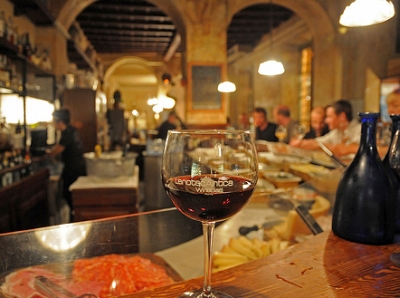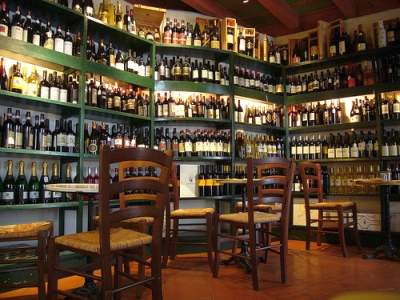
By Jude Polotan
Poor Giordano Bruno. Ten years just before Galileo would take the exact same stance, this former Dominican friar had the temerity to assert that the sun and not the Earth was the center of the universe, earning him a spot front and center in Rome’s Campo di’ Fiore, where he was burned at the stake.
400 years plus 1 decade later, I wait in the shadow of his imposing monument at day’s end, watching an army of street sweeping machines whoosh about the piazza seemingly willy-nilly to clean up immediately after the day’s busy fruit and vegetable marketplace. A fragrant cloud of squashed flowers, pulverized tomatoes and bruised basil fills my nostrils whilst tourists study the menu boards of cafes lining the piazza and locals lounge at outdoor tables smoking and drinking wine from juice glasses.
A Saturday night, the whiff of spring in the air, and the city is as clogged as ever with tourists. This afternoon I’d navigated my way through the throngs strangling Piazza Navona, spying no less than half a dozen significant tour groups, their guide waving high above his head the polka dot umbrella or the giant yellow daisy or the stick with a bright green ribbon tied to it. The customers, American and Japanese mostly, followed along like obedient puppies. I’ve constantly fantasized about how much a lot more enjoyable Rome would be were its streets not jammed with these packs of knee-socked, camera-toting, menu turistico-looking for folks from elsewhere. Where had been the real Romans? Caught behind 1 of these gaggles of tourists, no doubt.
And yet, although traditionally I have not been a proponent of guided tours — preferring to do my own research and make my own discoveries — on a previous trip to Rome, my companion and I had been solicited on the endless queue outside the Vatican Museums and were persuaded to join a modest group tour. Lured primarily by the promise of kicking back in a café although our guide waited on the two-hour line for us, the actual sweetness of the deal turned out to be the astonishingly knowledgeable guide himself, a friendly South African with a Ph.D. in art history who spewed out nuggets of priceless and juicy data that resulted in a far richer experience than we could ever have had on our own. Given that prosperous foray then, with caution, I amended my position. A carefully chosen tour with a really knowledgeable, personable guide can lend an additional dimension.
It was this enlightened outlook that had provoked me to sign up this trip for a three-hour tour with the clever name, “Rome by the Glass,” which promised the opportunity to “indulge your inner Bacchus” as a certified sommelier brought you to nearby, authentic enoteche and educated you on the regional wines of Italy.
 Which brings me to be hanging out with the heretic Bruno under the afternoon’s waning sun waiting for Ettore. It is not quite six p.m., dusk descending, when he finds me and informs me I’m his only client tonight, and with out further ado, we set off in the direction of our first enoteca. Ettore points out sights along the way: the Piazza Farnese, one of his preferred piazzas and one overlooked by tourists, the Holocaust memorial plaque and the Star of David on a red wall in the Jewish Ghetto, the captivating Fountain of the Turtles in the Piazza Mattei. He walks fast, talks quicker and, for the moment, all I can manage is a nod, a smile. I feel shy, the only tourist on a group tour.
Which brings me to be hanging out with the heretic Bruno under the afternoon’s waning sun waiting for Ettore. It is not quite six p.m., dusk descending, when he finds me and informs me I’m his only client tonight, and with out further ado, we set off in the direction of our first enoteca. Ettore points out sights along the way: the Piazza Farnese, one of his preferred piazzas and one overlooked by tourists, the Holocaust memorial plaque and the Star of David on a red wall in the Jewish Ghetto, the captivating Fountain of the Turtles in the Piazza Mattei. He walks fast, talks quicker and, for the moment, all I can manage is a nod, a smile. I feel shy, the only tourist on a group tour.
Enoteca Il Piccolo is tucked away in a small cobblestone street shooting off the Piazza Navona. True to its name, the enoteca is tiny — a handful of wooden tables squeezed together in a rustic searching space, bottles of wine shelved along the walls from waist height to the ceiling. There’s only one remaining table, the 1 closest to the bar, and I move some boxes of foodstuffs off the chair. It’s aperitivo time and along the short bar, an array of snacks beckons: bite-sized pizzas, olives, bread, spinach wrapped in turkey, roast pork. I collect a bit of everything on a little plate although Ettore engages in a really passionate conversation with the young man behind the bar, presumably ordering a couple of white wines to taste. When he returns to the table, I raise my eyebrows and he understands. “In Italy,” he says with a resigned shrug, “everything is a negotiation.”
 Naturally our conversation at initial centers about wine. Ettore’s understanding turns out to be really vast and I get the distinct impression that as a lot details as he’s feeding me, it constitutes only a fraction of all he knows. He tells me there are 450 varieties of grapes found throughout Italy. He explains about color and perfume and acidity and legs. Those are just the basics.
Naturally our conversation at initial centers about wine. Ettore’s understanding turns out to be really vast and I get the distinct impression that as a lot details as he’s feeding me, it constitutes only a fraction of all he knows. He tells me there are 450 varieties of grapes found throughout Italy. He explains about color and perfume and acidity and legs. Those are just the basics.
Our initial taste is a Sauvignon from the Veneto region. Ettore swirls the wine in the glass. I mimic his movement and some of the wine splashes out of my glass. He pretends not to notice and I like that about him. Now Ettore peers at his wine. Note the barely yellow color, like straw. Note how lengthy the wine clings to the side of the glass — not long, meaning low alcohol content. Note the smell — slightly grassy. This Sauvignon has been served fairly cold, allowing for much more perfume while reducing acidity. It is a young wine, he says. Much less exposure to the sun, much less heat, give the wine its crispness. At last we drink. I hold the wine in my mouth a moment and close my eyes. I’m not great at this, I really feel silly, but the Sauvignon playing on my tongue reminds me of a gentle summer night, a slight breeze riffling my hair, and I feel, this tour is going to be all right.
The second wine arrives and Ettore hasn’t finished emphasizing the importance of temperature, employing Coca-Cola as an illustration of the relationship between temperature and acidity: the warmer the Coca-Cola, the extra acidic. And because it takes 3 minutes to warm the wine by one degree Celsius, a superior sommelier will serve the wine a degree or two colder than ideal realizing it will take a few minutes prior to the customer picks it up and drinks. Well now, that clears it all up.
By now I’m thirsty and surely our Grecía Salentina has warmed sufficiently, so I raise my glass. “This is a a lot more direct wine,” says Ettore, hailing from Avellino, a region of Compania. He leads me through the steps: inspecting very first the more golden color, then swirling again to show how the legs stick to the glass longer, evidence of the higher alcohol content. I swirl along with him, additional gently this time, and wait for the legs to drip back down.
As we drink, the legs of our conversation grow stickier. The language of wine is so technical, I say to Ettore, commending him on his fluency in English, which prompts him to reveal his secret weapon: an American wife, originally from San Diego. He tells me the story of how they met a decade earlier, when he was selling sweet, peachy wine to undiscriminating tourists in Florence. Soon after obtaining married, they started their tour firm together. Then it is my turn. Learning that my partner’s son is 23, he shakes his head.
“In America,” he says, “he’s a man already, but in Italy he would barely be weaned.” Ettore himself is an exception, of course, but he laments the immaturity of his male compatriots, noting that even although it is changing, when Italian men marry, most still expect their wives to do all the cleaning, cooking, shopping, child-rearing and handling of household finances.
Time for the next enoteca, and threading our way by way of the nighttime bustle of the city, we touch upon Obama and American politics, the depressed real estate costs in Puglia and his incomprehension of American fashion. What Ettore can’t understand is why American kids wear their jeans hanging down off their butts. In Italy, he points out, it’s the exact opposite — the tighter, the greater. “I’ve noticed,” I say, and we laugh like two old pals.
At La Vecchia Bottega del Vino in the Jewish Ghetto, Ettore orders us a plate of nearby charcuterie and an additional of cheeses. Although we nibble on prosciutto and speck, bresaola and mortadella, we sample the 1st of two reds, a Nero d’Avola from Sicily The heat of the sun comes into play here. In most places, the days are warm, the nights cool, but in Sicily the nights are also warm — resulting in an specially dark grape that produces a smooth, hearty wine tasting of plums and smoke.
With the cheese plate comes the lustier Barbaresco, product of Piedmont. The Barbaresco has the longest legs yet. We swirl and sniff and sip although we shift now to the topic of kids, and I’m surprised to learn that Italy has the second lowest birth rate (Spain is 1st) in the western world and that couple of Italian women have additional than one child. Ettore chalks it up to economics, but I wonder. Whatever the reason, at this point, a lot more Italians are dying every year than being born. Thinking about the Catholic majority in the country and the proximity of the Vatican, this is a revelation to me.
Ettore and I are getting a very good time. We could linger over this table all night, but his wife is waiting on him for dinner and, right after all, this is a paid tour, not a night out with a friend — while the distinction is hardly clear at this point.
By the time we part enterprise, it is practically 10 p.m., four hours given that I stared up at Giordano Bruno. Given his prominence, I imagine Bruno sees fairly a lot of tour groups congregating at his feet. I reflect on the Inquisition which sentenced the former friar to death back in 1600, when apparently no one had a pretty open mind. I’m still skeptical about how many tours (and there are so numerous in Rome) give you a real feeling for the city, how many take you beyond the standard tourist pabulum, but after my enjoyable and educational night with Ettore, I’ll hold off on burning any tour guides at the stake.

[Enoteca by Tom Kelly/Flickr Campo di Fiore by Brad Eatherly/Flickr Enoteca il Piccolo by Ekunz/Flickr]
Comments
Post a Comment